Caesium
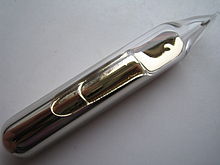 | ||||||||||||||||||||||||||||||||||||||
| Caesium | ||||||||||||||||||||||||||||||||||||||
|---|---|---|---|---|---|---|---|---|---|---|---|---|---|---|---|---|---|---|---|---|---|---|---|---|---|---|---|---|---|---|---|---|---|---|---|---|---|---|
| Pronunciation | /ˈsiːziəm/ | |||||||||||||||||||||||||||||||||||||
| Alternative name | cesium (US) | |||||||||||||||||||||||||||||||||||||
| Appearance | pale gold | |||||||||||||||||||||||||||||||||||||
| Standard atomic weight Ar°(Cs) | ||||||||||||||||||||||||||||||||||||||
| Caesium in the periodic table | ||||||||||||||||||||||||||||||||||||||
| ||||||||||||||||||||||||||||||||||||||
kJ/mol | ||||||||||||||||||||||||||||||||||||||
| Heat of vaporization | 63.9 kJ/mol | |||||||||||||||||||||||||||||||||||||
| Molar heat capacity | 32.210 J/(mol·K) | |||||||||||||||||||||||||||||||||||||
Vapour pressure
| ||||||||||||||||||||||||||||||||||||||
| Atomic properties | ||||||||||||||||||||||||||||||||||||||
Discovery | Robert Bunsen and Gustav Kirchhoff (1860) | |||||||||||||||||||||||||||||||||||||
| First isolation | Carl Setterberg (1882) | |||||||||||||||||||||||||||||||||||||
| Isotopes of caesium | ||||||||||||||||||||||||||||||||||||||
| ||||||||||||||||||||||||||||||||||||||
Caesium (
The German chemist Robert Bunsen and physicist Gustav Kirchhoff discovered caesium in 1860 by the newly developed method of flame spectroscopy. The first small-scale applications for caesium were as a "getter" in vacuum tubes and in photoelectric cells. Caesium is widely used in highly accurate atomic clocks. In 1967, the International System of Units began using a specific hyperfine transition of neutral caesium-133 atoms to define the basic unit of time, the second.
Since the 1990s, the largest
Characteristics
Physical properties

Of all elements that are solid at room temperature, caesium is the softest: it has a hardness of 0.2 Mohs. It is a very
colour.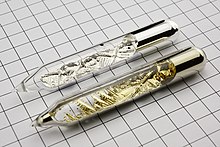
Caesium forms
2 is black with a purple metallic lustre, while CsHg is golden-coloured, also with a metallic lustre.[23]
The golden colour of caesium comes from the decreasing frequency of light required to excite electrons of the alkali metals as the group is descended. For lithium through rubidium this frequency is in the ultraviolet, but for caesium it enters the blue–violet end of the spectrum; in other words, the plasmonic frequency of the alkali metals becomes lower from lithium to caesium. Thus caesium transmits and partially absorbs violet light preferentially while other colours (having lower frequency) are reflected; hence it appears yellowish.[24]
Allotropes
Caesium exists in the form of different allotropes, one of them a dimer called dicaesium.[25]
Chemical properties
Caesium metal is highly reactive and
The chemistry of caesium is similar to that of other alkali metals, in particular
Compounds
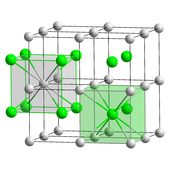
Most caesium compounds contain the element as the
Salts of Cs+ are usually colourless unless the anion itself is coloured. Many of the simple salts are
A stoichiometric mixture of caesium and gold will react to form yellow caesium auride (Cs+Au−) upon heating. The auride anion here behaves as a pseudohalogen. The compound reacts violently with water, yielding caesium hydroxide, metallic gold, and hydrogen gas; in liquid ammonia it can be reacted with a caesium-specific ion exchange resin to produce tetramethylammonium auride. The analogous platinum compound, red caesium platinide (Cs2Pt), contains the platinide ion that behaves as a pseudochalcogen.[36]
Complexes
Like all metal cations, Cs+ forms complexes with
Halides
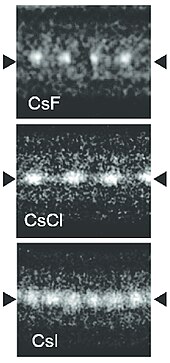
181 pm.[40]
Oxides

11O
3 cluster
More so than the other alkali metals, caesium forms numerous binary compounds with
2 type.[43] It vaporizes at 250 °C (482 °F), and decomposes to caesium metal and the peroxide Cs
2O
2 at temperatures above 400 °C (752 °F). In addition to the superoxide and the ozonide CsO
3,[44][45] several brightly coloured suboxides have also been studied.[46] These include Cs
7O, Cs
4O, Cs
11O
3, Cs
3O (dark-green[47]), CsO, Cs
3O
2,[48] as well as Cs
7O
2.[49][50] The latter may be heated in a vacuum to generate Cs
2O.[43] Binary compounds with sulfur, selenium, and tellurium also exist.[14]
Isotopes
Caesium has 41 known

The radioactive
The isotope 135Cs is one of the
The
Almost all caesium produced from nuclear fission comes from the beta decay of originally more neutron-rich fission products, passing through various isotopes of iodine and xenon.[63] Because iodine and xenon are volatile and can diffuse through nuclear fuel or air, radioactive caesium is often created far from the original site of fission.[64] With nuclear weapons testing in the 1950s through the 1980s, 137Cs was released into the atmosphere and returned to the surface of the earth as a component of radioactive fallout. It is a ready marker of the movement of soil and sediment from those times.[14]
Occurrence

Caesium is a relatively rare element, estimated to average 3
Due to its large
2O
6), which is found in a few places around the world in zoned pegmatites, associated with the more commercially important lithium minerals, lepidolite and petalite. Within the pegmatites, the large grain size and the strong separation of the minerals results in high-grade ore for mining.[67]
The world's most significant and richest known source of caesium is the Tanco Mine at Bernic Lake in Manitoba, Canada, estimated to contain 350,000 metric tons of pollucite ore, representing more than two-thirds of the world's reserve base.[67][68] Although the stoichiometric content of caesium in pollucite is 42.6%, pure pollucite samples from this deposit contain only about 34% caesium, while the average content is 24 wt%.[68] Commercial pollucite contains more than 19% caesium.[69] The Bikita pegmatite deposit in Zimbabwe is mined for its petalite, but it also contains a significant amount of pollucite. Another notable source of pollucite is in the Karibib Desert, Namibia.[68] At the present rate of world mine production of 5 to 10 metric tons per year, reserves will last for thousands of years.[14]
Production
Mining and refining pollucite ore is a selective process and is conducted on a smaller scale than for most other metals. The ore is crushed, hand-sorted, but not usually concentrated, and then ground. Caesium is then extracted from pollucite primarily by three methods: acid digestion, alkaline decomposition, and direct reduction.[14][70]
In the acid digestion, the silicate pollucite rock is dissolved with strong acids, such as hydrochloric (HCl), sulfuric (H
2SO
4), hydrobromic (HBr), or hydrofluoric (HF) acids. With hydrochloric acid, a mixture of soluble chlorides is produced, and the insoluble chloride double salts of caesium are precipitated as caesium antimony chloride (Cs
4SbCl
7), caesium iodine chloride (Cs
2ICl), or caesium hexachlorocerate (Cs
2(CeCl
6)). After separation, the pure precipitated double salt is decomposed, and pure CsCl is precipitated by evaporating the water.
The sulfuric acid method yields the insoluble double salt directly as caesium alum (CsAl(SO
4)
2·12H
2O). The aluminium sulfate component is converted to insoluble aluminium oxide by roasting the alum with carbon, and the resulting product is leached with water to yield a Cs
2SO
4 solution.[14]
Roasting pollucite with calcium carbonate and calcium chloride yields insoluble calcium silicates and soluble caesium chloride. Leaching with water or dilute ammonia (NH
4OH) yields a dilute chloride (CsCl) solution. This solution can be evaporated to produce caesium chloride or transformed into caesium alum or caesium carbonate. Though not commercially feasible, the ore can be directly reduced with potassium, sodium, or calcium in vacuum to produce caesium metal directly.[14]
Most of the mined caesium (as salts) is directly converted into
Alternatively, caesium metal may be obtained from the purified compounds derived from the ore. Caesium chloride and the other caesium halides can be reduced at 700 to 800 °C (1,292 to 1,472 °F) with calcium or barium, and caesium metal distilled from the result. In the same way, the aluminate, carbonate, or hydroxide may be reduced by magnesium.[14]
The metal can also be isolated by
- Cs
2Cr
2O
7 + 2 Zr → 2 Cs + 2 ZrO
2+ Cr
2O
3
The price of 99.8% pure caesium (metal basis) in 2009 was about $10 per gram ($280/oz), but the compounds are significantly cheaper.[68]
History
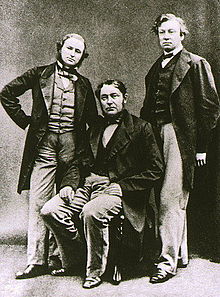
In 1860, Robert Bunsen and Gustav Kirchhoff discovered caesium in the mineral water from Dürkheim, Germany. Because of the bright blue lines in the emission spectrum, they derived the name from the Latin word caesius, meaning 'bluish grey'.[note 6][73][74][75] Caesium was the first element to be discovered with a spectroscope, which had been invented by Bunsen and Kirchhoff only a year previously.[18]
To obtain a pure sample of caesium, 44,000 litres (9,700 imp gal; 12,000 US gal) of mineral water had to be evaporated to yield 240 kilograms (530 lb) of concentrated salt solution. The alkaline earth metals were precipitated either as sulfates or oxalates, leaving the alkali metal in the solution. After conversion to the nitrates and extraction with ethanol, a sodium-free mixture was obtained. From this mixture, the lithium was precipitated by ammonium carbonate. Potassium, rubidium, and caesium form insoluble salts with chloroplatinic acid, but these salts show a slight difference in solubility in hot water, and the less-soluble caesium and rubidium hexachloroplatinate ((Cs,Rb)2PtCl6) were obtained by fractional crystallization. After reduction of the hexachloroplatinate with hydrogen, caesium and rubidium were separated by the difference in solubility of their carbonates in alcohol. The process yielded 9.2 grams (0.32 oz) of rubidium chloride and 7.3 grams (0.26 oz) of caesium chloride from the initial 44,000 litres of mineral water.[74]
From the caesium chloride, the two scientists estimated the
Historically, the most important use for caesium has been in research and development, primarily in chemical and electrical fields. Very few applications existed for caesium until the 1920s, when it came into use in radio
Since 1967, the
Applications
Petroleum exploration
The largest present-day use of nonradioactive caesium is in
The high density of the caesium formate brine (up to 2.3 g/cm3, or 19.2 pounds per gallon),
2 solutions) sometimes do; they also require less cleanup and reduce disposal costs.[14]
Atomic clocks

Caesium-based
Definition of the second
The second, symbol s, is the SI unit of time. The
Electric power and electronics
Caesium vapour thermionic generators are low-power devices that convert heat energy to electrical energy. In the two-electrode vacuum tube converter, caesium neutralizes the space charge near the cathode and enhances the current flow.[86]
Caesium is also important for its photoemissive properties, converting light to electron flow. It is used in photoelectric cells because caesium-based cathodes, such as the intermetallic compound K
2CsSb, have a low threshold voltage for emission of electrons.[87] The range of photoemissive devices using caesium include optical character recognition devices, photomultiplier tubes, and video camera tubes.[88][89] Nevertheless, germanium, rubidium, selenium, silicon, tellurium, and several other elements can be substituted for caesium in photosensitive materials.[14]
Caesium iodide (CsI), bromide (CsBr) and fluoride (CsF) crystals are employed for scintillators in scintillation counters widely used in mineral exploration and particle physics research to detect gamma and X-ray radiation. Being a heavy element, caesium provides good stopping power with better detection. Caesium compounds may provide a faster response (CsF) and be less hygroscopic (CsI).
Caesium vapour is used in many common magnetometers.[90]
The element is used as an internal standard in spectrophotometry.[91] Like other alkali metals, caesium has a great affinity for oxygen and is used as a "getter" in vacuum tubes.[92] Other uses of the metal include high-energy lasers, vapour glow lamps, and vapour rectifiers.[14]
Centrifugation fluids
The high density of the caesium ion makes solutions of caesium chloride, caesium sulfate, and caesium trifluoroacetate (Cs(O
2CCF
3)) useful in molecular biology for density gradient ultracentrifugation.[93] This technology is used primarily in the isolation of viral particles, subcellular organelles and fractions, and nucleic acids from biological samples.[94]
Chemical and medical use

Relatively few chemical applications use caesium.[95] Doping with caesium compounds enhances the effectiveness of several metal-ion catalysts for chemical synthesis, such as acrylic acid, anthraquinone, ethylene oxide, methanol, phthalic anhydride, styrene, methyl methacrylate monomers, and various olefins. It is also used in the catalytic conversion of sulfur dioxide into sulfur trioxide in the production of sulfuric acid.[14]
Nuclear and isotope applications
Caesium-137 is a radioisotope commonly used as a gamma-emitter in industrial applications. Its advantages include a half-life of roughly 30 years, its availability from the nuclear fuel cycle, and having 137Ba as a stable end product. The high water solubility is a disadvantage which makes it incompatible with large pool irradiators for food and medical supplies.[97] It has been used in agriculture, cancer treatment, and the sterilization of food, sewage sludge, and surgical equipment.[14][98] Radioactive isotopes of caesium in radiation devices were used in the medical field to treat certain types of cancer,[99] but emergence of better alternatives and the use of water-soluble caesium chloride in the sources, which could create wide-ranging contamination, gradually put some of these caesium sources out of use.[100][101] Caesium-137 has been employed in a variety of industrial measurement gauges, including moisture, density, levelling, and thickness gauges.[102] It has also been used in well logging devices for measuring the electron density of the rock formations, which is analogous to the bulk density of the formations.[103]
Caesium-137 has been used in hydrologic studies analogous to those with tritium. As a daughter product of fission bomb testing from the 1950s through the mid-1980s, caesium-137 was released into the atmosphere, where it was absorbed readily into solution. Known year-to-year variation within that period allows correlation with soil and sediment layers. Caesium-134, and to a lesser extent caesium-135, have also been used in hydrology to measure the caesium output by the nuclear power industry. While they are less prevalent than either caesium-133 or caesium-137, these bellwether isotopes are produced solely from anthropogenic sources.[104]
Other uses

Caesium and mercury were used as a propellant in early ion engines designed for spacecraft propulsion on very long interplanetary or extraplanetary missions. The fuel was ionized by contact with a charged tungsten electrode. But corrosion by caesium on spacecraft components has pushed development in the direction of inert gas propellants, such as xenon, which are easier to handle in ground-based tests and do less potential damage to the spacecraft.[14] Xenon was used in the experimental spacecraft Deep Space 1 launched in 1998.[105][106] Nevertheless, field-emission electric propulsion thrusters that accelerate liquid metal ions such as caesium have been built.[107]
Caesium salts have been evaluated as antishock reagents following the administration of
Caesium-133 can be laser cooled and used to probe fundamental and technological problems in quantum physics. It has a particularly convenient Feshbach spectrum to enable studies of ultracold atoms requiring tunable interactions.[114]
Health and safety hazards
| Hazards | |
|---|---|
| GHS labelling:[115] | |
 
| |
| Danger | |
| H260, H314 | |
| P223, P231+P232, P280, P305+P351+P338, P370+P378, P422 | |
| NFPA 704 (fire diamond) | |

Nonradioactive caesium compounds are only mildly toxic, and nonradioactive caesium is not a significant environmental hazard. Because biochemical processes can confuse and substitute caesium with
The median lethal dose (LD50) for caesium chloride in mice is 2.3 g per kilogram, which is comparable to the LD50 values of potassium chloride and sodium chloride.[119] The principal use of nonradioactive caesium is as caesium formate in petroleum drilling fluids because it is much less toxic than alternatives, though it is more costly.[80]
Caesium metal is one of the most reactive elements and is highly
It is highly pyrophoric: the autoignition temperature of caesium is −116 °C (−177 °F), and it ignites explosively in air to form caesium hydroxide and various oxides. Caesium hydroxide is a very strong base, and will rapidly corrode glass.[19]
The
See also
- Caesium-137 § Incidents and accidents
- Acerinox accident, a caesium-137 contamination accident in 1998
- Goiânia accident, a major radioactive contamination incident in 1987 involving caesium-137
- Kramatorsk radiological accident, a 137Cs lost-source incident between 1980 and 1989
Notes
- ligature æ as cæsius; hence, an alternative but now old-fashioned orthography is cæsium. More spelling explanation at ae/oe vs e.
- ^ Along with rubidium (39 °C [102 °F]), francium (estimated at 27 °C [81 °F]), mercury (−39 °C [−38 °F]), and gallium (30 °C [86 °F]); bromine is also liquid at room temperature (melting at −7.2 °C [19.0 °F]), but it is a halogen and not a metal. Preliminary work with copernicium and flerovium suggests that they are gaseous metals at room temperature.
- ^ The radioactive element francium may also have a lower melting point, but its radioactivity prevents enough of it from being isolated for direct testing.[17] Copernicium and flerovium may also have lower melting points.
- ^ It differs from this value in caesides, which contain the Cs− anion and thus have caesium in the −1 oxidation state.[28] Additionally, 2013 calculations by Mao-sheng Miao indicate that under conditions of extreme pressure (greater than 30 GPa), the inner 5p electrons could form chemical bonds, where caesium would behave as the seventh 5p element. This discovery indicates that higher caesium fluorides with caesium in oxidation states from +2 to +6 could exist under such conditions.[29]
- periodic trends.[31]
- ^ Bunsen quotes Aulus Gellius Noctes Atticae II, 26 by Nigidius Figulus: Nostris autem veteribus caesia dicts est quae Graecis, ut Nigidus ait, de colore coeli quasi coelia.
References
- ^ "Standard Atomic Weights: Caesium". CIAAW. 2013.
- ISSN 1365-3075.
- ^ ISBN 978-1-62708-155-9.
- ISBN 1-4398-5511-0.
- .
- ISBN 0-8493-0487-3. Retrieved 26 September 2010.
- .
- NIST. Retrieved 13 March 2011.
- ^ "IUPAC Periodic Table of Elements". International Union of Pure and Applied Chemistry.
- ISBN 0-85404-438-8. pp. 248–49. Electronic version..
- ISBN 978-0-8412-3999-9.
- (PDF) from the original on 21 May 2011.
- ^ OED entry for "caesium". Second edition, 1989; online version June 2012. Retrieved 7 September 2012. Earlier version first published in New English Dictionary, 1888.
- ^ a b c d e f g h i j k l m n o p q r s t u v w x y z aa Butterman, William C.; Brooks, William E.; Reese, Robert G. Jr. (2004). "Mineral Commodity Profile: Cesium" (PDF). United States Geological Survey. Archived from the original (PDF) on 7 February 2007. Retrieved 27 December 2009.
- ISBN 978-0-8306-3015-8.
- ISBN 978-0-471-90508-0. Retrieved 28 September 2012.
- ^ "Francium". Periodic.lanl.gov. Retrieved 23 February 2010.
- ^ a b c d e Kaner, Richard (2003). "C&EN: It's Elemental: The Periodic Table – Cesium". American Chemical Society. Retrieved 25 February 2010.
- ^ a b "Chemical Data – Caesium – Cs". Royal Society of Chemistry. Retrieved 27 September 2010.
- ^ ISBN 978-0-8493-2321-8.
- ^ a b Clark, Jim (2005). "Flame Tests". chemguide. Retrieved 29 January 2012.
- ^ Taova, T. M.; et al. (22 June 2003). Density of melts of alkali metals and their Na-K-Cs and Na-K-Rb ternary systems (PDF). Fifteenth symposium on thermophysical properties, Boulder, Colorado, United States. Archived from the original (PDF) on 9 October 2006. Retrieved 26 September 2010.
- .
- ISBN 9780471905080.
- PMID 33737625.
- ISBN 1-57912-895-5.
- ^ ISBN 978-0-08-022057-4.
- ^ .
- ^ Moskowitz, Clara. "A Basic Rule of Chemistry Can Be Broken, Calculations Show". Scientific American. Retrieved 22 November 2013.
- ^ ISBN 978-3-11-007511-3.
- PMID 10035190.
- S2CID 38839337.
- S2CID 102912809.
- ^ Hogan, C. M. (2011)."Phosphate". Archived from the original on 25 October 2012. Retrieved 17 June 2012. in Encyclopedia of Earth. Jorgensen, A. and Cleveland, C.J. (eds.). National Council for Science and the Environment. Washington DC
- ]
- .
- ).
- PMID 26228378.
- .
- ISBN 978-0-19-855370-0.
- ISBN 978-0-471-84997-1.
- ISBN 0-8493-0487-3.
- ^ doi:10.1021/j150537a022. Archived from the originalon 24 September 2017.
- .
- S2CID 250883291.
- .
- .
- S2CID 96084147.
- .
- .
- (PDF) from the original on 10 October 2022. Retrieved 20 February 2010.
- ISBN 978-0-691-01147-9.
- .
- .
- ^ Sonzogni, Alejandro. "Interactive Chart of Nuclides". National Nuclear Data Center: Brookhaven National Laboratory. Archived from the original on 22 May 2008. Retrieved 6 June 2008.
- ^ Ohki, Shigeo; Takaki, Naoyuki (14–16 October 2002). Transmutation of Cesium-135 with Fast Reactors (PDF). Seventh Information Exchange Meeting on Actinide and Fission Product Partitioning and Transmutation. Jeju, Korea. Archived from the original (PDF) on 28 September 2011. Retrieved 26 September 2010.
- ^ "20 Xenon: A Fission Product Poison" (PDF). CANDU Fundamentals (Report). CANDU Owners Group Inc. Archived from the original (PDF) on 23 July 2011. Retrieved 15 September 2010.
- PMID 17869392.
- ^ "Cesium | Radiation Protection". U.S. Environmental Protection Agency. 28 June 2006. Archived from the original on 15 March 2011. Retrieved 15 February 2010.
- ^ Zerriffi, Hisham (24 May 2000). IEER Report: Transmutation – Nuclear Alchemy Gamble (Report). Institute for Energy and Environmental Research. Retrieved 15 February 2010.
- ^ Chernobyl's Legacy: Health, Environmental and Socia-Economic Impacts and Recommendations to the Governments of Belarus, Russian Federation and Ukraine (PDF) (Report). International Atomic Energy Agency. Archived from the original (PDF) on 15 February 2010. Retrieved 18 February 2010.
- .
- ISBN 978-1-56032-088-3.
- OSTI 5714707.
- ISSN 0016-7606.
- ^ Rowland, Simon (4 July 1998). "Cesium as a Raw Material: Occurrence and Uses". Artemis Society International. Archived from the original on 8 July 2021. Retrieved 15 February 2010.
- ^ a b Černý, Petr; Simpson, F. M. (1978). "The Tanco Pegmatite at Bernic Lake, Manitoba: X. Pollucite" (PDF). Canadian Mineralogist. 16: 325–333. Archived (PDF) from the original on 10 October 2022. Retrieved 26 September 2010.
- ^ a b c d Polyak, Désirée E. "Cesium" (PDF). U.S. Geological Survey. Archived (PDF) from the original on 8 May 2009. Retrieved 17 October 2009.
- ^ Norton, J. J. (1973). "Lithium, cesium, and rubidium—The rare alkali metals". In Brobst, D. A.; Pratt, W. P. (eds.). United States mineral resources. Vol. Paper 820. U.S. Geological Survey Professional. pp. 365–378. Archived from the original on 21 July 2010. Retrieved 26 September 2010.
- ^ ISBN 978-0-471-48494-3.
- ^ Benton, William; Turner, Jim (2000). "Cesium formate fluid succeeds in North Sea HPHT field trials" (PDF). Drilling Contractor (May/June): 38–41. Archived (PDF) from the original on 6 July 2001. Retrieved 26 September 2010.
- ^ ISBN 978-3-11-011451-5.
- ^ Oxford English Dictionary, 2nd Edition
- ^ (PDF) from the original on 2 March 2016.
- ^ .
- ISBN 978-1-4067-5938-9.
- .
- ^ Strod, A. J. (1957). "Cesium—A new industrial metal". American Ceramic Bulletin. 36 (6): 212–213.
- ^ a b "Cesium Atoms at Work". Time Service Department—U.S. Naval Observatory—Department of the Navy. Archived from the original on 23 February 2015. Retrieved 20 December 2009.
- ^ doi:10.2118/99068-MS. Archived from the originalon 12 October 2007.
- ^ Flatern, Rick (2001). "Keeping cool in the HPHT environment". Offshore Engineer (February): 33–37.
- S2CID 4191481.
- .
- ^ Reel, Monte (22 July 2003). "Where timing truly is everything". The Washington Post. p. B1. Archived from the original on 29 April 2013. Retrieved 26 January 2010.
- ^ "Resolution 1 of the 26th CGPM" (in French and English). Paris: Bureau International des Poids et Mesures. 2018. pp. 472 of the official French publication. Archived from the original on 4 February 2021. Retrieved 29 December 2019.
- .
- ^ "Cesium Supplier & Technical Information". American Elements. Retrieved 25 January 2010.
- .
- S2CID 121613539.
- S2CID 36065775.
- ISBN 978-0-471-28572-4.
- ISBN 978-0-12-014528-7.
- .
- ISBN 978-0-89603-564-5.
- ISBN 978-0-471-15158-6.
- ^ Friestad, Gregory K.; Branchaud, Bruce P.; Navarrini, Walter and Sansotera, Maurizio (2007) "Cesium Fluoride" in Encyclopedia of Reagents for Organic Synthesis, John Wiley & Sons.
- ^ Okumura, Takeshi (21 October 2003). "The material flow of radioactive cesium-137 in the U.S. 2000" (PDF). United States Environmental Protection Agency. Archived from the original (PDF) on 20 July 2011. Retrieved 20 December 2009.
- ^ Jensen, N. L. (1985). "Cesium". Mineral facts and problems. Vol. Bulletin 675. U.S. Bureau of Mines. pp. 133–138.
- ^ "IsoRay's Cesium-131 Medical Isotope Used In Milestone Procedure Treating Eye Cancers At Tufts-New England Medical Center". Medical News Today. 17 December 2007. Retrieved 15 February 2010.
- ISBN 978-0-07-005115-7. Retrieved 26 September 2010.
- ISBN 978-0-309-11014-3.
- ISBN 978-0-412-53400-3.
- .
- ^ Kendall, Carol. "Isotope Tracers Project – Resources on Isotopes – Cesium". National Research Program – U.S. Geological Survey. Retrieved 25 January 2010.
- .
- ^ Sovey, James S.; Rawlin, Vincent K.; Patterson, Michael J. "A Synopsis of Ion Propulsion Development Projects in the United States: SERT I to Deep Space I" (PDF). NASA. Archived from the original (PDF) on 29 June 2009. Retrieved 12 December 2009.
- ^ Marrese, C.; Polk, J.; Mueller, J.; Owens, A.; Tajmar, M.; Fink, R. & Spindt, C. (October 2001). In-FEEP Thruster Ion Beam Neutralization with Thermionic and Field Emission Cathodes. 27th International Electric Propulsion Conference. Pasadena, California. pp. 1–15. Archived from the original (PDF) on 27 May 2010. Retrieved 25 January 2010.
- ^ "Infrared illumination compositions and articles containing the same". United States Patent 6230628. Freepatentsonline.com. Retrieved 25 January 2010.
- ^ "LUU-19 Flare". Federation of American Scientists. 23 April 2000. Archived from the original on 6 August 2010. Retrieved 12 December 2009.
- .
- ISBN 978-1-84176-098-8.
- ISBN 978-0-309-07448-3. Retrieved 26 September 2010.
- ISBN 978-0-86214-250-6.
- S2CID 118340314.
- ^ "Cesium 239240". Sigma-Aldrich. 26 September 2021. Retrieved 21 December 2021.
- ^ Data from The Radiochemical Manual and Wilson, B. J. (1966) The Radiochemical Manual (2nd ed.).
- S2CID 19186683.
- .
- PMID 1154391.
- PMID 14120787.
- S2CID 10293954.
- .
- PMID 1580386.
- PMID 20334900.
- ISBN 978-3-540-23866-9.
- S2CID 127482742.
- PMID 5030090.
- ^ "Chinese 'find' radioactive ball". BBC News. 27 March 2009. Retrieved 25 January 2010.
- ^ Charbonneau, Louis (12 March 2003). "IAEA director warns of 'dirty bomb' risk". The Washington Post. Reuters. p. A15. Archived from the original on 5 December 2008. Retrieved 28 April 2010.
External links
- Caesium or Cesium at The Periodic Table of Videos(University of Nottingham)
- View the reaction of Caesium (most reactive metal in the periodic table) with Fluorine (most reactive non-metal) courtesy of The Royal Institution.
- Rogachev, Andrey Yu.; Miao, Mao-Sheng; Merino, Gabriel; Hoffmann, Roald (2015). "Molecular CsF5and CsF2+". Angewandte Chemie. 127 (28): 8393–8396. .

